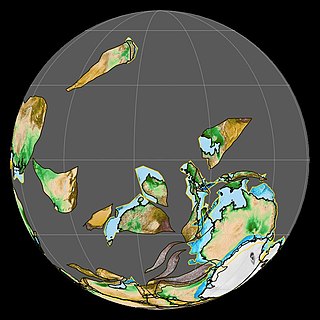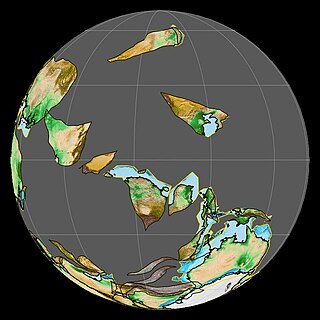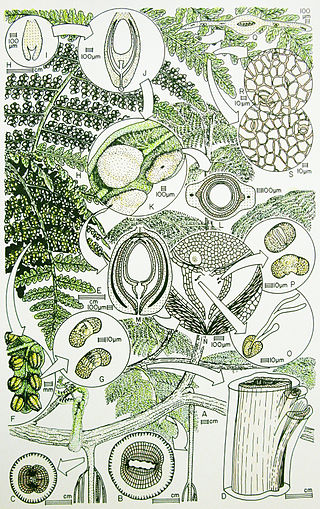Related Research Articles

The Carboniferous is a geologic period and system of the Paleozoic that spans 60 million years from the end of the Devonian Period 358.9 Ma to the beginning of the Permian Period, 298.9 Ma. In North America, the Carboniferous is often treated as two separate geological periods, the earlier Mississippian and the later Pennsylvanian.
The Pennsylvanian is, on the ICS geologic timescale, the younger of two subperiods of the Carboniferous Period. It lasted from roughly 323.2 million years ago to 298.9 million years ago. As with most other geochronologic units, the rock beds that define the Pennsylvanian are well identified, but the exact date of the start and end are uncertain by a few hundred thousand years. The Pennsylvanian is named after the U.S. state of Pennsylvania, where the coal-producing beds of this age are widespread.
In the geologic timescale, the Asselian is the earliest geochronologic age or lowermost chronostratigraphic stage of the Permian. It is a subdivision of the Cisuralian Epoch or Series. The Asselian lasted between 298.9 and 293.52 million years ago (Ma). It was preceded by the Gzhelian and followed by the Sakmarian.
The Bashkirian is in the International Commission on Stratigraphy geologic timescale the lowest stage or oldest age of the Pennsylvanian. The Bashkirian age lasted from 323.2 to 315.2 Ma, is preceded by the Serpukhovian and is followed by the Moscovian.

The Tournaisian is in the ICS geologic timescale the lowest stage or oldest age of the Mississippian, the oldest subsystem of the Carboniferous. The Tournaisian age lasted from 358.9 Ma to 346.7 Ma. It is preceded by the Famennian and is followed by the Viséan. In global stratigraphy, the Tournaisian contains two substages: the Hastarian and Ivorian. These two substages were originally designated as European regional stages.

The Serpukhovian is in the ICS geologic timescale the uppermost stage or youngest age of the Mississippian, the lower subsystem of the Carboniferous. The Serpukhovian age lasted from 330.9 Ma to 323.2 Ma. It is preceded by the Visean and is followed by the Bashkirian. The Serpukhovian correlates with the lower part of the Namurian Stage of European stratigraphy and the middle and upper parts of the Chesterian Stage of North American stratigraphy.
The Kasimovian is a geochronologic age or chronostratigraphic stage in the ICS geologic timescale. It is the third stage in the Pennsylvanian, lasting from 307 to 303.7 Ma. The Kasimovian Stage follows the Moscovian and is followed by the Gzhelian. The Kasimovian saw an extinction event which occurred around 305 mya, referred to as the Carboniferous Rainforest Collapse. It roughly corresponds to the Missourian in North American geochronology and the Stephanian in western European geochronology.

The Gzhelian is an age in the ICS geologic timescale or a stage in the stratigraphic column. It is the youngest stage of the Pennsylvanian, the youngest subsystem of the Carboniferous. The Gzhelian lasted from 303.7 to 298.9 Ma. It follows the Kasimovian age/stage and is followed by the Asselian age/stage, the oldest subdivision of the Permian system.

Cochleosaurus (“spoon lizard”, from the Latin cochlear "spoon" and Greek sauros “lizard”_ were medium-sized edopoid temnospondyls that lived in Euramerica during the Muscovian period. Two species, C. bohemicus and C. florensis, have been identified from the fossil record.

Euproops is an extinct genus of xiphosuran, related to the modern horseshoe crab. It lived during the Carboniferous Period.

The Allegheny Group, often termed the Allegheny Formation, is a Pennsylvanian-age geological unit in the Appalachian Plateau. It is a major coal-bearing unit in the eastern United States, extending through western and central Pennsylvania, western Maryland and West Virginia, and southeastern Ohio. Fossils of fishes such as Bandringa are known from the Kittaning Formation, which is part of the Allegheny Group.
The Moscovian is in the ICS geologic timescale a stage or age in the Pennsylvanian, the youngest subsystem of the Carboniferous. The Moscovian age lasted from 315.2 to 307 Ma, is preceded by the Bashkirian and is followed by the Kasimovian. The Moscovian overlaps with the European regional Westphalian stage and the North American Atokan and Desmoinesian stages.
The Namurian is a stage in the regional stratigraphy of northwest Europe, with an age between roughly 331 and 319 Ma. It is a subdivision of the Carboniferous system or period, as well as the regional Silesian series. The Namurian is named for the Belgian city and province of Namur where strata of this age occur. The Millstone Grit Group in the lithostratigraphy of northern England and parts of Wales is also of Namurian age.
The Stephanian is a stage in the regional stratigraphy of northwest Europe with an age between roughly 307.5 and 299 Ma. It is a subdivision of the Carboniferous system or period and the regional Silesian series. The uppermost units of the Coal Measures of England and Wales are probably of Stephanian age, though the larger part of this formation is referred to the earlier Westphalian. The stage derives its name from the city of Saint-Étienne for its coal mining basin in eastern central France where strata of this age occur.

The Callistophytaceae was a family of seed ferns (pteridosperms) from the Carboniferous and Permian periods. They first appeared in late Middle Pennsylvanian (Moscovian) times, 306.5–311.7 million years ago (Ma) in the tropical coal forests of Euramerica, and became an important component of Late Pennsylvanian vegetation of clastic soils and some peat soils. The best known callistophyte was documented from Late Pennsylvanian coal ball petrifactions in North America.

The Carboniferous rainforest collapse (CRC) was a minor extinction event that occurred around 305 million years ago in the Carboniferous period. The event occurred at the end of the Moscovian and continued into the early Kasimovian stages of the Pennsylvanian.

In lithostratigraphy, coal measures are coal-bearing strata, with the term typically applied to European units of the Upper Carboniferous System.
The South Wales Coal Measures Group is a lithostratigraphical term referring to the coal-bearing succession of rock strata which occur in South Wales within the Westphalian Stage of the Carboniferous Period. The Group name is also applied to rocks of similar age across southern England from the Bristol Coalfield east to the concealed Oxfordshire, Berkshire and Kent Coalfields. In formal use, the term replaces the earlier Coal Measures Group The Group comprises the:

Macroneuropteris is a genus of Carboniferous seed plants in the order Medullosales. The genus is best known for the species Macroneuropteris scheuchzeri, a medium-size tree that was common throughout the late Carboniferous Euramerica. Three similar species, M. macrophylla, M. britannica and M. subauriculata are also included in the genus.
The Scottish Coal Measures Group is a lithostratigraphic unit referring to the coal-bearing succession of rock strata which occur in Scotland during the Westphalian regional stage of the Carboniferous Period. It is the Scottish portion of the informal Coal Measures Group, which also includes the South Wales and Pennine coal measures. The Scottish coal measures are well-exposed across the Midland Valley. The group is also found within small grabens in the vicinity of Sanquhar and Thornhill.
References
- 1 2 3 Cohen, K. M.; Finney, S. C.; Gibbard, P. L.; Fan, J X. (2023). "International chronostratigraphic chart". www.stratigraphy.org.
- 1 2 Opluštil, Stanislav; Laurin, Jiří; Hýlová, Lada; Jirásek, Jakub; Schmitz, Mark; Sivek, Martin (2022-05-01). "Coal-bearing fluvial cycles of the late Paleozoic tropics; astronomical control on sediment supply constrained by high-precision radioisotopic ages, Upper Silesian Basin". Earth-Science Reviews. 228: 103998. Bibcode:2022ESRv..22803998O. doi:10.1016/j.earscirev.2022.103998. ISSN 0012-8252.
- 1 2 3 4 5 Knight, John A.; Cleal, Christopher J.; Álvarez-Vázquez, Carmen (2023-06-14). "The challenge of relating the Kasimovian to west European chronostratigraphy: a critical review of the Cantabrian and Barruelian substages of the Stephanian Stage". Geological Society, London, Special Publications. 535 (1): 31–71. Bibcode:2023GSLSP.535..189K. doi: 10.1144/SP535-2022-189 . ISSN 0305-8719.
- 1 2 3 4 5 6 Aretz, M.; Herbig, H.G.; Wang, X.D.; Gradstein, F.M.; Agterberg, F.P.; Ogg, J.G. (2020), "The Carboniferous Period", Geologic Time Scale 2020, Elsevier, pp. 811–874, doi:10.1016/b978-0-12-824360-2.00023-1, ISBN 978-0-12-824360-2 , retrieved 2023-10-09
- 1 2 3 4 5 6 Opluštil, Stanislav; Schmitz, Mark; Cleal, Christopher J.; Martínek, Karel (2016). "A review of the Middle–Late Pennsylvanian west European regional substages and floral biozones, and their correlation to the Geological Time Scale based on new U–Pb ages". Earth-Science Reviews. 154: 301–335. Bibcode:2016ESRv..154..301O. doi:10.1016/j.earscirev.2016.01.004.
- 1 2 3 4 5 Waters, C.N. (2011-07-13), Waters, C.N.; Somerville, I.D.; Jones, N.S.; Cleal, C.J. (eds.), "Definitions of chronostratigraphic subdivisions: geochronology and event stratigraphy", A Revised Correlation of Carboniferous Rocks in the British Isles (First ed.), The Geological Society of London, pp. 3–10, doi:10.1144/sr26.2, ISBN 978-1-86239-694-4 , retrieved 2023-10-09
- 1 2 Waters, C.N.; Somerville, I.D.; Stephenson, M.H.; Cleal, C.J.; Long, S.L. (2011-07-13), Waters, C.N.; Somerville, I.D.; Jones, N.S.; Cleal, C.J. (eds.), "Biostratigraphy", A Revised Correlation of Carboniferous Rocks in the British Isles (First ed.), The Geological Society of London, pp. 11–22, doi:10.1144/sr26.3, ISBN 978-1-86239-694-4 , retrieved 2023-10-09
- 1 2 3 4 5 6 7 8 9 10 11 Opluštil, Stanislav; Cleal, Christopher J.; Wang, Jun; Wan, Mingli (2022). "Carboniferous macrofloral biostratigraphy: an overview". Geological Society, London, Special Publications. 512 (1): 813–863. Bibcode:2022GSLSP.512..813O. doi:10.1144/SP512-2020-97. ISSN 0305-8719.
- 1 2 3 Pointon, Michael A.; Chew, David M.; Ovtcharova, Maria; Sevastopulo, George D.; Crowley, Quentin G. (2012). "New high-precision U–Pb dates from western European Carboniferous tuffs; implications for time scale calibration, the periodicity of late Carboniferous cycles and stratigraphical correlation". Journal of the Geological Society. 169 (6): 713–721. Bibcode:2012JGSoc.169..713P. doi:10.1144/jgs2011-092. hdl: 2262/79149 . ISSN 0016-7649.
- 1 2 3 4 5 Molina-Solís, Azucena; Cleal, Christopher J.; Capel, Eliott; Cascales-Miñana, Borja (2023). "Vegetation dynamics in the Early–Middle Pennsylvanian coal swamps of the Nord-Pas-de-Calais Coalfield, France". Palaeoworld. 33 (2): 328–340. doi:10.1016/j.palwor.2023.04.005.
- ↑ Wagner, R.H.; Sánchez de Posada, L.C.; Martínez Chacón, M.L.; Fernández, L.P.; Villa, E.; Winkler Prins, C.F. (2002). "The Asturian Stage: a preliminary proposal for the definition of a substitute for Westphalian D". Canadian Society of Petroleum Geologists, Memoir. 19: 832–850.
- ↑ Wittry, Jack; Glasspool, Ian J.; Béthoux, Olivier; Koll, Rebecca; Cleal, Christopher J. (2015-08-03). "A revision of the Pennsylvanian marattialean fern Lobatopteris vestita auct . and related species". Journal of Systematic Palaeontology. 13 (8): 615–643. Bibcode:2015JSPal..13..615W. doi:10.1080/14772019.2014.936915. ISSN 1477-2019.
- ↑ Hook, R. W.; Ferm, J. C. (1985). "A depositional model for the Linton tetrapod assemblage (Westphalian D, Upper Carboniferous) and its palaeonenvironmental significance". Philosophical Transactions of the Royal Society of London. B 311 (1148): 101–108.
- ↑ Hook, R. W.; Baird, D. (1986). "The Diamond Coal Mine of Linton, Ohio, and its Pennsylvanian-age vertebrates". Journal of Vertebrate Paleontology. 6 (2): 174–190. Bibcode:1986JVPal...6..174H. doi:10.1080/02724634.1986.10011609.
- ↑ Babcock, L. E. (2024). "Replacement names for two species of Orthacanthus Agassiz, 1843 (Chondrichthyes, Xenacanthiformes), and discussion of Giebelodus Whitley, 1940, replacement name for Chilodus Giebel, 1848 (Chondrichthyes, Xenacanthiformes), preoccupied by Chilodus Müller & Troschel, 1844 (Actinopterygii, Characiformes)". ZooKeys (1188): 219–226. doi: 10.3897/zookeys.1188.108571 .
- ↑ Sahney, S., Benton, M.J. & Falcon-Lang, H.J. (2010). "Rainforest collapse triggered Pennsylvanian tetrapod diversification in Euramerica" (PDF). Geology. 38 (12): 1079–1082. doi:10.1130/G31182.1.
{{cite journal}}: CS1 maint: multiple names: authors list (link) - ↑ M. Alan Kazlev (1998) The Carboniferous Period of the Paleozoic Era: 299 to 359 million years ago, Palaeos.org, Retrieved on 2008-06-23